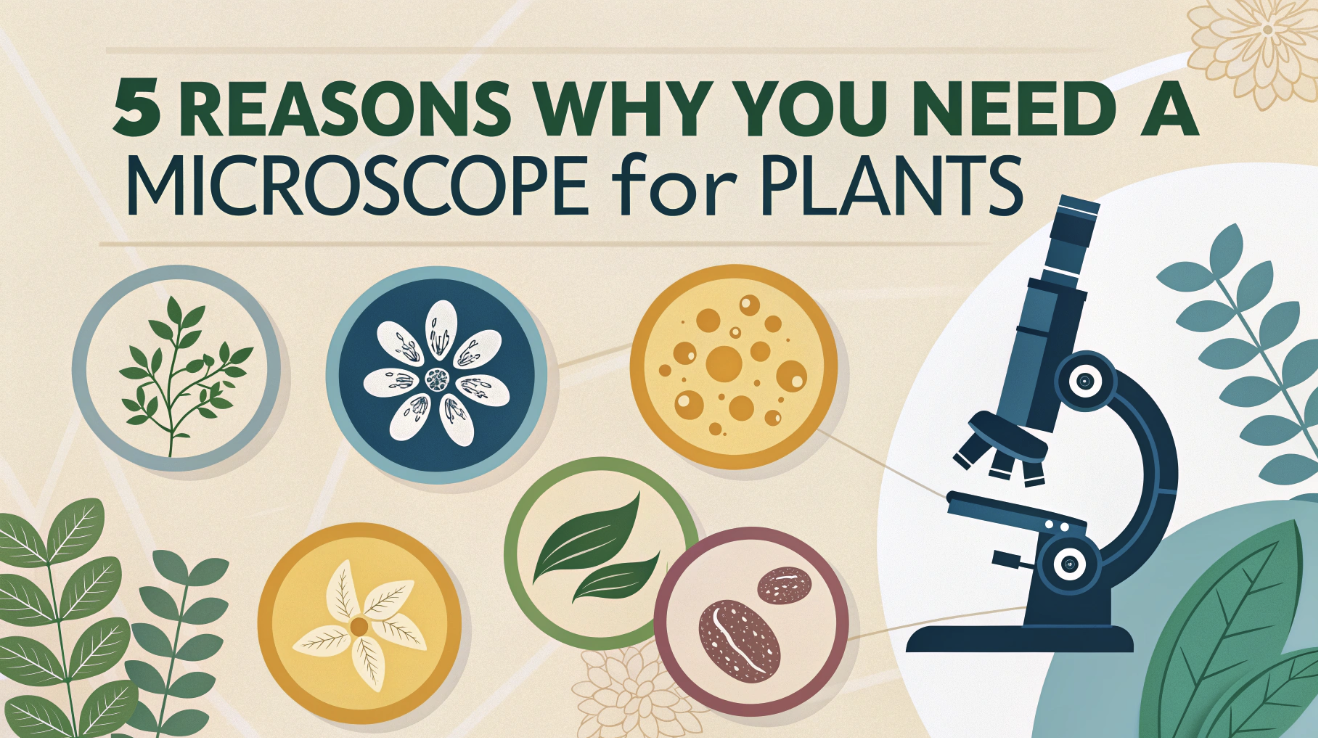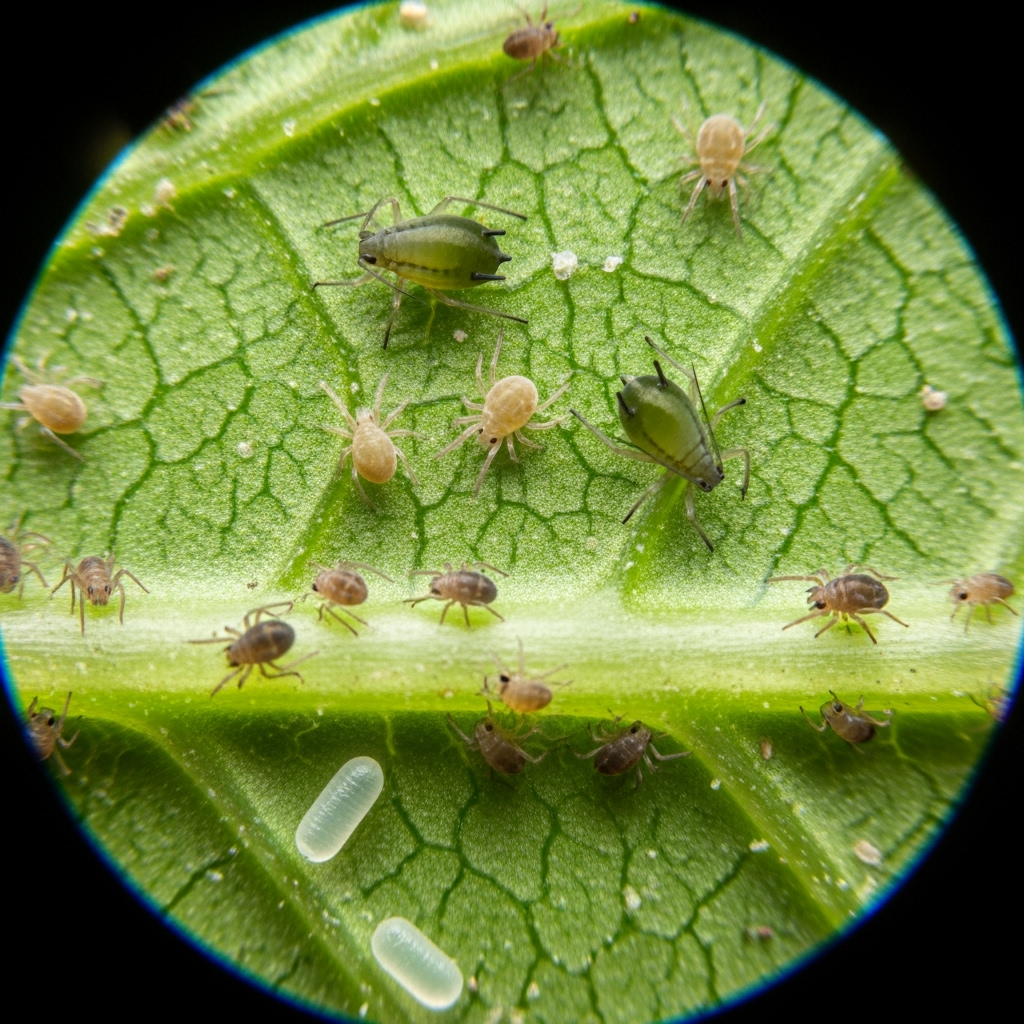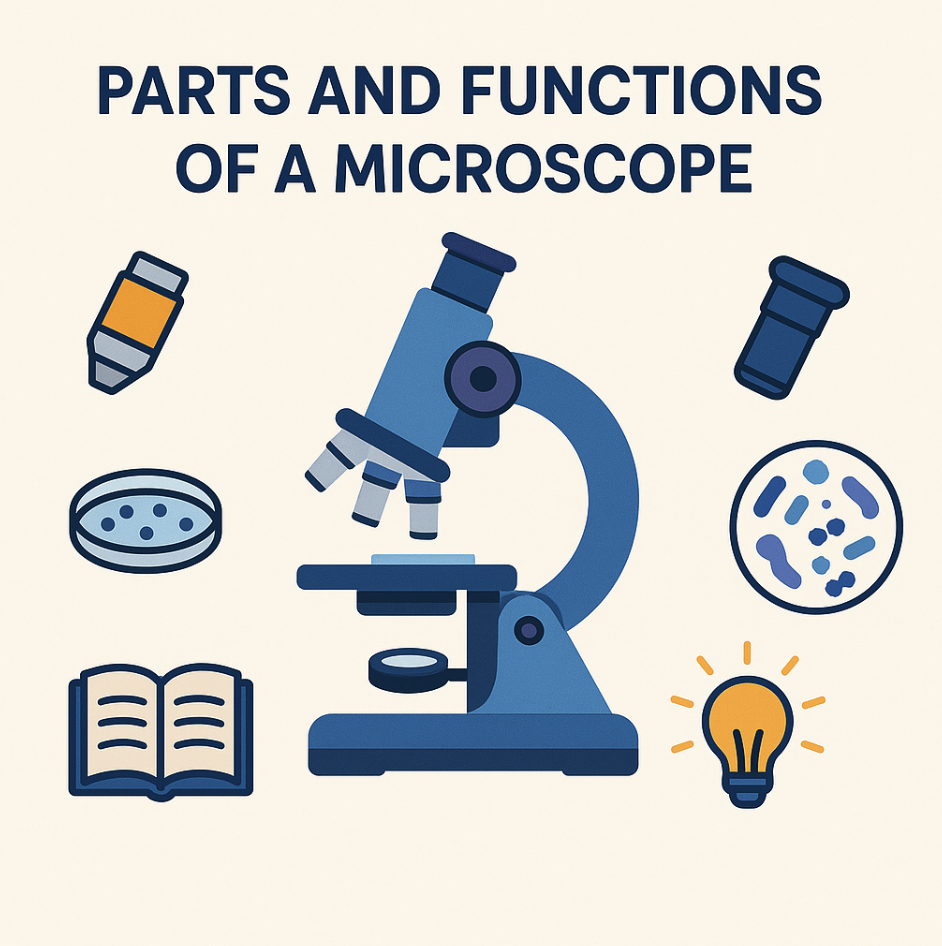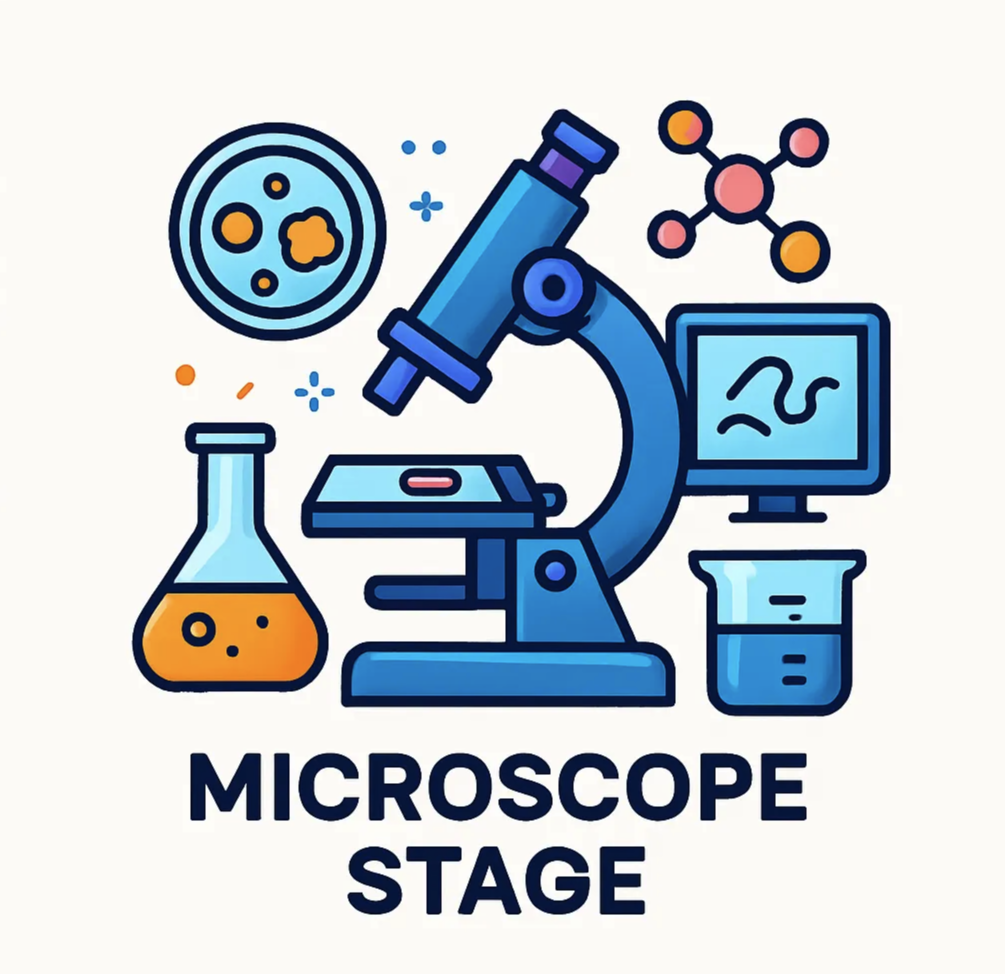
Think of a microscope as your secret weapon for next-level plant care. It lets you peek into a hidden universe, revealing everything from how your plants drink water to the first signs of a pest invasion. Suddenly, you’re not just guessing what they need; you’re seeing it with your own eyes. This is your chance to truly understand your green companions and become the best plant parent you can be. It’s time we start looking at plants differently and discover the fascinating, tiny world they hide.
It’s an exciting chance to connect more deeply with nature!
Enhanced Observation with a Microscope for Plants
Imagine holding a tiny universe in your hands, where every glance reveals a new secret of nature. A microscope for plants offers you this extraordinary opportunity. It transforms the way you perceive plant life, allowing you to get into the intricate details that are otherwise hidden from view.
In this section, we will explore how a microscope enhances your observation skills and deepens your understanding of plant structures and features.
Detailed Examination of Plant Structures
Understanding plant cells and tissues
When you peer through a microscope, you unlock the world of plant cells and tissues. This tool enables you to explore the fundamental building blocks of life, offering insights into how plants function and thrive. You can observe the cell walls, chloroplasts, and other cellular components that play crucial roles in photosynthesis and nutrient transport. This detailed examination helps you understand how plants respond to environmental stresses and adapt to their surroundings.
According to studies, microscopic observation can reveal evidence of environmental stresses and damage in plant cells, aiding in early detection of crop stresses and diseases.
Observing plant growth and development
A microscope also lets you witness the fascinating process of plant growth and development. You can track how a seed germinates and transforms into a mature plant. By observing these stages, you gain a deeper appreciation for the complexity of plant lifecycles. This knowledge empowers you to make informed decisions about plant care, ensuring optimal growth conditions.
Microscopes have revolutionized the study of plant tissues and processes, enabling a deeper understanding of plant biology.
Uncovering Hidden Details
Identifying plant features not visible to the naked eye
With a microscope, you can uncover plant features that remain invisible to the naked eye. This tool reveals the intricate patterns on leaves, the delicate structures of flowers, and the unique textures of stems. By identifying these hidden details, you enhance your ability to diagnose plant health issues and recognize signs of disease or pest infestations early on.
Such a proactive approach helps you maintain healthy plants and prevent potential problems.
Enhancing visual appreciation of plant diversity
The diversity of plant life becomes even more captivating when viewed under a microscope. You can explore the vast array of shapes, colors, and textures that make each plant species unique. This enhanced visual appreciation fosters a deeper connection with nature and inspires curiosity about the natural world. Discovering the microscopic world enhances your understanding of the intricate and beautiful nature of plants.
Microscopes for Viewing Plant Cells
The most suitable microscopes for viewing plant cells, including detailed observation of cell walls, chloroplasts, and other cellular components, are:
-
Light Microscopes (Compound Microscopes)
- Ideal for basic viewing of plant cell structures such as cell walls, chloroplasts, vacuoles, and nuclei.
- Magnification typically ranges from 1000 to 2000x, sufficient to see cell walls and chloroplasts clearly.
- Variants include bright-field, phase-contrast, and differential interference contrast (DIC) microscopes for enhanced contrast in live or unstained cells.
-
- Use fluorescent dyes or markers to highlight specific cellular components like chloroplasts or cell wall molecules.
- Confocal laser scanning microscopes (e.g., ZEISS LSM 980) provide high-resolution, 3D optical sections and can separate autofluorescence from multiple markers, ideal for detailed plant cell imaging.
-
Stereo (Dissecting) Microscopes
- Useful for observing whole plant tissues or larger structures before zooming into cellular details with higher magnification microscopes.
-
Electron Microscopes
- Transmission Electron Microscopes (TEM): Provide ultrastructural details inside cells, such as thylakoid membranes within chloroplasts and detailed cell wall architecture at very high magnifications (up to 500,000x).
- Scanning Electron Microscopes (SEM): Offer 3D surface views of plant cells and tissues, useful for studying cell wall surface morphology.
-
Advanced Microscopy Techniques
- Light-sheet microscopy and lattice light-sheet microscopy enable fast, gentle 3D imaging of live plant cells with minimal photodamage, making them useful for observing dynamic processes.
- Super-Resolution Microscopy: Breaks the diffraction limit of light to reveal very fine details within plant cells beyond conventional light microscopy.
- Volume Electron Microscopy (vEM): For 3D ultrastructural insights into plant tissues.
In summary, for basic plant cell observation, including cell walls and chloroplasts, a compound light microscope with bright-field or phase-contrast optics is suitable. For higher resolution and 3D imaging, confocal laser scanning microscopes and electron microscopes (TEM and SEM) provide detailed views of cellular components and ultrastructure.
Advanced techniques, such as light-sheet and super-resolution microscopy, offer cutting-edge capabilities for live and high-resolution imaging of plant cells.
Disease Detection through Looking at Plants Under a Microscope
Imagine the frustration of nurturing your beloved plants, only to see them wither due to an unseen enemy. A microscope for plants becomes your ally in this battle, offering a window into the microscopic world where pathogens lurk.
In this section, we will explore how a microscope aids in the early detection of plant diseases and empowers you to implement preventative care strategies.
Early Identification of Pathogens
Spotting fungal infections
Fungal infections can devastate plants if not detected early. With a microscope, you can spot these infections before they become visible to the naked eye. This tool allows you to observe the spores and hyphae that indicate fungal presence.
Raman microscopy, a non-invasive technique, provides rapid and accurate detection of such infections, distinguishing between healthy and infected tissues with high sensitivity. By identifying these signs early, you can take swift action to protect your plants.
Detecting bacterial and viral diseases
Bacterial and viral diseases often manifest subtly, making early detection crucial. A microscope reveals the cellular changes these pathogens cause, allowing you to detect infections before they spread. Techniques like Immunofluorescence (IF) enhance this process by using fluorescence to highlight the presence of pathogens in plant tissues.
This method has proven effective in identifying various plant infections, offering a powerful tool in your disease detection arsenal.
Preventative Plant Care
Implementing early treatment strategies
Once you identify a disease, the next step is to implement treatment strategies. Early detection through a microscope enables you to apply targeted treatments, minimizing damage and promoting recovery. You can use indirect methods like plant stress profiling to predict plant health and tailor your interventions accordingly. This proactive approach ensures your plants receive the care they need to thrive.
Reducing the spread of diseases
Preventing the spread of diseases is as important as treating them. A microscope helps you monitor disease progression and assess the effectiveness of your interventions. By understanding the disease dynamics, you can adjust your care strategies to contain infections and protect neighboring plants.
This vigilance reduces the risk of widespread outbreaks, safeguarding your entire garden.
Pest Identification Using a Microscope for Plants

Imagine the frustration of discovering tiny pests wreaking havoc on your cherished plants. These microscopic invaders often go unnoticed until significant damage occurs. A microscope becomes your essential tool in this battle, offering a detailed view of these pests and their life cycles.
In this section, we will examine how a microscope facilitates the identification and management of plant pests effectively.
Detecting Microscopic Pests
Identifying mites and aphids
Mites and aphids are common culprits in plant damage. They are often too small to see with the naked eye, making early detection challenging. With a microscope, you can easily identify these pests by examining their unique features.
Mites, for instance, have eight legs and a round body, while aphids are pear-shaped with long antennae. Recognizing these characteristics helps you take swift action to protect your plants from further harm.
Observing pest life cycles
Understanding the life cycles of pests is crucial for effective management. A microscope allows you to observe the different stages of pest development, from eggs to adults. This knowledge empowers you to target interventions at the most vulnerable stages, disrupting their life cycle and reducing their population.
Monitoring these cycles helps implement control measures, keeping plants healthy.
Effective Pest Management
Tailoring pest control methods
Once you identify the pests, the next step is to tailor your pest control methods. A microscope provides insights into the specific type of pest you’re dealing with, allowing you to choose the most effective treatment. For example, some pests may respond better to biological controls, while others require chemical interventions. By customizing your approach, you can minimize damage and promote plant recovery.
Monitoring pest populations
Regular monitoring of pest populations is essential for maintaining plant health. A microscope helps you track changes in pest numbers and assess the effectiveness of your control strategies. By keeping a close eye on these populations, you can adjust your methods as needed, preventing outbreaks and ensuring your garden remains a sanctuary for healthy plants.
Research and Experimentation with a Microscope for Plants
Imagine the thrill of discovering new insights about plant life through research and experimentation. A microscope becomes your gateway to this world, offering you the tools to conduct detailed studies and experiments that deepen your understanding of plant biology. Here, we will explore how examining plants under a microscope aids scientific research and experimentation, improving your understanding of plant growth and development.
Facilitating Scientific Research
Conducting detailed plant studies
When you use a microscope, you unlock the ability to conduct detailed studies of plant structures and functions. This tool allows you to observe cellular and subcellular processes, providing insights into how plants grow and adapt to their environment.
For instance, researchers at Université Paris-Saclay have proposed a new hypothesis suggesting that plant cell walls may have an intrinsic ability to grow. Such discoveries highlight the importance of microscopic observation in advancing our understanding of plant biology.
Contributing to botanical research
Your exploration with a microscope can also contribute to broader botanical research. By documenting your findings and sharing them with the scientific community, you contribute to building a collective knowledge base that supports future studies.
Microscopy plays a crucial role in studying plant structures and functions, offering valuable data that can inform conservation efforts and agricultural practices.
Your contributions, no matter how small, can make a significant impact on the field of botany.
Experimenting with Plant Growth
Testing growth conditions
A microscope enables you to experiment with different growth conditions and observe their effects on plants. You can test variables such as light, temperature, and soil composition to determine their impact on plant health and development. This hands-on approach allows you to identify optimal conditions for plant growth, ensuring that your plants thrive.
Recent advances in live imaging of plant cells have enabled the tracking of living cells as they divide and change shape, providing real-time insights into plant growth dynamics.
Observing effects of environmental changes
Environmental changes can have profound effects on plant health, and a microscope helps you observe these impacts at a cellular level. By examining plant tissues under a microscope, you can detect early signs of stress or damage caused by factors such as drought, pollution, or disease. This early warning system allows you to implement corrective measures before significant harm occurs.
Studies have shown that microscopic observation can serve as an early warning system for crop stresses, helping you maintain healthy and resilient plants.
A microscope for plants opens a window into the intricate world of plant biology. By looking at plants under a microscope, you gain insights into cellular structures and processes that are invisible to the naked eye. This tool empowers you to detect early signs of stress or disease, ensuring healthier plants and a more robust garden. Investing in a microscope enhances your ability to study and care for plants, offering both educational and practical benefits.
Consider adding this valuable instrument to your toolkit to unlock the secrets of the plant world and elevate your gardening experience.


